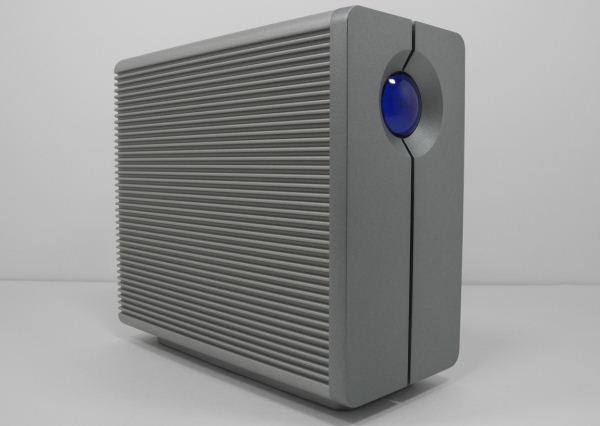LaCie's 2big NAS Review
by Ganesh T S on May 28, 2012 7:55 AM EST- Posted in
- IT Computing
- Storage
- NAS
- LaCie
The SMB (Small to Medium Businesses) / SOHO (Small Office / Home Office) NAS market is a highly competitive one. We have been reviewing a number of ARM-based 2-bay / 4-bay NAS units over the last year or so. In addition, we have also looked at some x86-based high-end systems such as the LaCie 5Big Storage Server and the QNAP TS-659 Pro II.
On May 15th, LaCie launched an updated version of their 2big Network 2 2-bay product, the 2big NAS. The 2big NAS comes in diskless and 6TB versions, priced at $299.99 and $649.00 respectively. At this price point, the NAS competes with advanced 2-bay SMB solutions such as the Synology DS211+, and not the LG NAS N2A2 (which is geared primarily towards home users). In this review, we set out to find whether the features and performance match up to the price point.
The purpose of any NAS is to serve as a centralized repository for data while also having some sort of redundancy built in. The redundancy helps in data recovery, in case of media failure or any other unforeseen circumstances. In addition to the standard RAID levels, some companies also offer custom redundancy solutions. The OS on the NAS also varies across vendors.
High-end NAS systems for SMBs and enterprise run on Windows Storage Server. However, most of the other 2-bay and 4-bay variants run on customized OSes with a Linux kernel at its core. While Synology has Disk Station Manager (DSM) which runs even on the 8-bay models and QNAP has Turbo NAS, LaCie revamped their ARM-based OS last August with the release of LaCie NAS OS 2.
The LaCie 2-bay NAS supports RAID 0 (striping) as well as RAID 1 (mirroring). In this review, we are primarily concerned with RAID-1 performance. We will start off with the unboxing and setup impressions, followed by a system teardown. We are in the midst of revamping our NAS testbed, and the testbed setup for this review will give readers an indicator of where we eventually want to get with respect a standardized platform for evaluating NAS units. Following the testbed description, we have Windows and Linux benchmarks using Intel NASPT and IOMeter respectively. We will conclude the review with a discussion of the miscellaneous factors and provide some concluding remarks.











15 Comments
View All Comments
DukeRobillard22 - Tuesday, May 29, 2012 - link
The question I always have about a NAS, and which is hard to find out, is "what filesystem does it use?" Like, when its power supply dies, can I pull one of the mirrored disks out, plug it into a SATA port on my Linux box, and get at the data? While it's true the the disks themselves are probably the mostly likely thing to fail, they're not the only thing.Currently, I use an old PC running Fedora with software RAID, just so I can do that when some piece of hardware lets out the magic smoke.
KLC - Tuesday, May 29, 2012 - link
Every time I read an NAS review I'm struck by how expensive they are. More than 2 years ago I bought an Acer Windows Home Server box. It has 4 hot swappable drive bays, an atom processor with 1 gb of memory and Windows Home Server V1. With one 1tb drive it cost me $350 on sale, regular price was $399. Two years later and I see systems with less capability than that one yet they are much more expensive. Why do NAS systems defy Moore's law of more computing capability for less money over time?EddieBoy - Wednesday, May 30, 2012 - link
I keep thinking that I need something to replace my aging Windows Home Server setup. This looks like it might do the trick.But now I am concerned about the Seagate acquisition and whether that might affect their quality and customer support.
Any thoughts on how the acquisition might affect this company?
Thanks.
Zak - Sunday, June 3, 2012 - link
Do these overheat and fry their electronics like most of LaCie enclosures?klassobanieras - Tuesday, June 12, 2012 - link
As the owner of a 4-disk ReadyNAS NV I always felt quite smug about my data until the box itself went bad. This taught me to ask certain awkward questions:- What if the box fails? Do I need to buy another identical box to get my data off my disks or will (e.g.) a Linux machine understand them ok?
- Is it susceptible to the RAID write-hole? Do I need a UPS?
- What kind of data-integrity does it provide, relative to the state-of-the-art (ZFS, btrfs et al)?
Respectfully, I'd suggest that if you're going to seriously test NASes you need to (a) repeatedly yank the power-cord in the middle of metadata-heavy writes, (b) try getting your data off the disks without the use of the NAS itself, (c) see how it deals with a flaky drive and (d) test for data integrity, not just filesystem integrity.
Finally, NASes should be judged in the context of what you can get from an el-cheapo PC running FreeNAS with ZFS, which IMHO puts most consumer NAS boxes to shame.